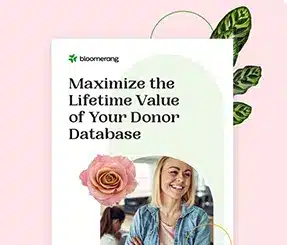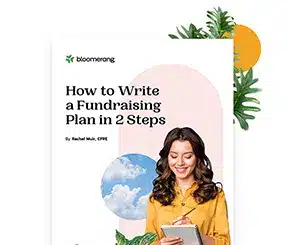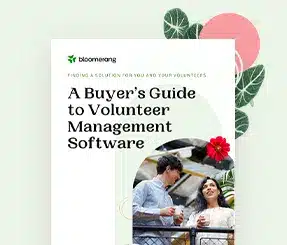Nonprofit Gratitude Strategies


Full Platform Overview Chat With Us



Full Platform Overview Chat With Us




Okay, your year-end fundraising blitz is over. Now what? Do not simply take the money and run — consider nonprofit gratitude.
Think of January as “Thank You Month.” Shower the donors you love with love… show them the way that you feel… things are gonna get much better if you only…
If you only channel ‘Miss Manners!’
I write a lot about the power of nonprofit gratitude, and you can read some of what I’ve had to say here, here, and here. You really can’t say thank you too often, and research shows the more prompt and personal you can be, the better. So really take advantage of this month – while the gift is still fresh in your donor’s mind — to heap on your authentic thankfulness.
Make it super donor-centric and personal. It comes directly from you to them, not “on behalf of your organization or clients.” It uses personal language, not jargon or robotic corporate speak. Before you send it, read it aloud to make sure it sounds warm and friendly. Include folks who gave online (if you have their address), even if you already sent an email thank you. It never hurts to get more than one thank you, and sometimes folks don’t even notice the email. Plus with a mailed letter you can add special inserts and notes.
This is an especially good idea for donors who earmark their gift to a specific program. Donors like knowing the program received the gift, and who better to tell them how the gift will be put to work than the person responsible for running the program? An additional letter might come from:
Let first-time donors know in your first thank you letter or email you’ll be following up with a Welcome Package. This gives them something to look forward to, and you an opportunity to show you can be trusted! A week or two after the initial thank you, follow through! The goal is say thank you again, and also offer up a slew of other donor-centered benefits. Nothing expensive. Just notice they’re new, and let them know some ways they can become involved that don’t involve making another monetary gift. Not yet.
Think from your donor’s perspective. They want an idea of how they can become welcomed, integral members of your community. Here are some things you can include:
I like to call all first-time donors if possible. If your list is too large, I recommend calling donors of $100+. This is a significant amount for a first-time donor, and generally an indication the gift is more than just a token. There’s something about your mission the donor really likes. Your goal is to make them feel they made a good decision – and to do so right away before they begin to wonder!
Below you’ll find suggestions of other donors to call. It’s not exhaustive. It’s okay if the call comes from a staff member, so incorporate these calls into someone’s job description. This is not a long call. Generally, it’s not even a conversation. It’s short, sweet, and to the point. (Grab my free “Donor Thank You Calls + Script e-Book ”).
January is a terrific time to send donors a calendar year-end letter summarizing their giving for the year. But don’t just send a boring receipt; that’s a waste of paper and postage. Take the opportunity to tell your donors what their giving accomplished, and be sure to tell them how wonderful they are!
Also, include the info they need for tax purposes, but put this at the bottom below your signature.
The goal is to show donors they mean more to you than they thought they did. This is a critical step if you want the ‘next gift.’
Right after a campaign is a good time to call out your recent donors to thank them for all the wonderful things their support makes possible. So include a ‘thank you’ feature in whatever you’re sending to folks this month. While you’re at it, why not offer folks a little ‘gift of content’ as a thank you? Donors want less lecture, more love. Offer:
You probably know which platforms are most used by your constituents. Why not send a general post with a big fat year-end thank you? It can be prose, a photo, a video or whatever else makes sense for you. For major donors, you can send a more targeted, personal thank you via direct messaging on the platform. Feel free to also think outside the box; there are a variety of ways to express gratitude using social media.
This is something that can be made via mobile phone or even a Zoom recording. It doesn’t have to be fancy. In fact, it’s almost better if it isn’t! There are numerous ways to send this video:
Get over 100 ideas on my Pinterest board: Gratitude: Nonprofits Say Thanks.
Donors love to hear from the folks they help. If client confidentiality is not a problem for you, you can share directly with videos or thank you notes. If it is, you can share quotations or thank you excerpts while keeping the client’s identity anonymous. You can also get creative, and share what a dog… dolphin… tree… river… or painting had to say!
Never underestimate the power of thank you. It lets the donor know you received their gift, you appreciate it, and you’re going to use it precisely as they intended. This establishes trust, which is the foundation of all lasting relationships. Plus it just makes people like you more.
Donor communications should never be just about the money. Because gifts are never just about the money. They’re about outcomes the donor cherishes, and values they want to express. So thanking them for being kind, caring, and demonstrably generous is important. It makes supporters feel warm and fuzzy.
The receipt of the gift is the beginning, not the end. Your holy grail should be building the relationship so you’ll achieve donor loyalty. When donors like you, and you continue to make them feel good about their involvement with you, this makes them want to continue sticking with you!

Comments